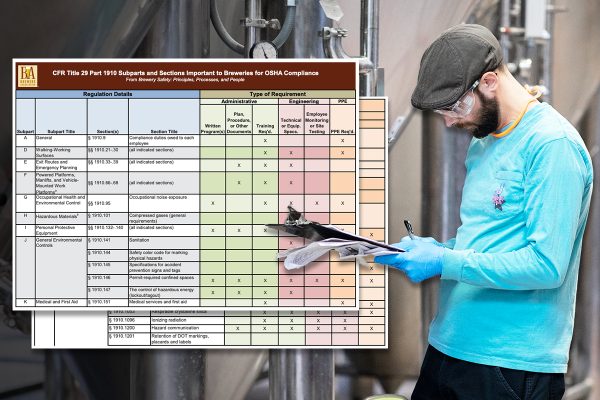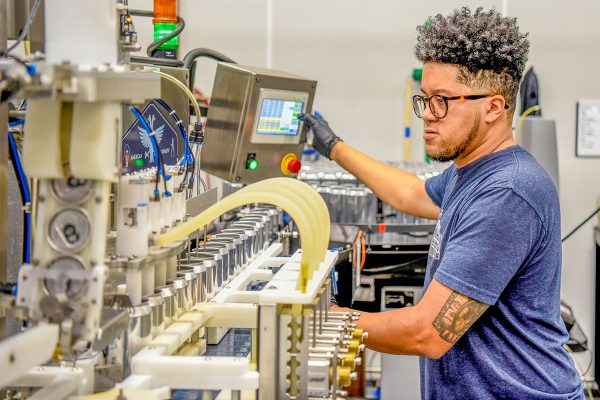Craft brewers continue to use large amounts of hops per barrel of beer brewed. The popularity of styles that require the use of dry hopping practices (for example, juicy and hazy IPAs) are the main driver of this hop usage trend. Dry hopping is the term for adding hops to a beer while in active fermentation or during maturation in the fermenter. The high demand for these dry-hopped beers increases the incidence of brewers performing the task of dry hopping, which in turn increases the risk of beer loss and/or worker injury due to the inherent hazards associated with this task.
The hazards of dry hopping can be mitigated through a two-step hazard assessment process: first understand the possible hazards associated with each step of the dry hop procedure, then choose ways to eliminate or control those hazards. Using the information this post, brewers can begin to develop a safe and successful dry hopping Standard Operating Procedure (SOP) for their facility by bringing awareness to general dry hopping hazards, such as pressure and asphyxiating gases, and hazard control strategies, such as proper ladder use, equipment limitations, and fundamental safety principles.
Hazards of Dry Hopping
The following is a general list of dry hopping hazards. Keep in mind, these hazards are exacerbated by rushing and multitasking. Extra time, planning, and mindfulness can increase safety across all brewery protocols.
- Flying and falling objects, such as a tri-clamp coin
- Exposure to high levels of carbon dioxide (CO2) or other asphyxiants
- Falling or getting knocked off a ladder or platform
- Clogged pressure/vacuum relief valve (PVRV) which could lead to over pressurization and catastrophic tank failure
- “Hop Volcano,” an industry term for when beer, hops, and CO2 violently erupt out of a fermenter from the port where hops are added during the dry hop
Control and Mitigate Dry Hopping Hazards
Step two of a hazard assessment is to choose ways to first eliminate and then control the hazards identified through safe working practices, engineering controls, personal protective equipment, and administrative efforts. In the sections below, readers will find important hazard elimination and control strategies to consider when building their dry hopping SOP.
Safe Working Practices
- Depressurize the tank before dry hopping. This should be clearly detailed in the SOP. Always recognize and take into consideration the dissolved CO2 volumes in the beer.
- Do not stand directly above or over any port when opening and adding hops. Stand to the side of the port instead to keep out of the “line of fire.” This will prevent injury from flying hardware. Production personnel should not stand below the port while dry hopping is in process.
- Monitor for CO2 exposure. Breathing off-gassed CO2 directly can cause dizziness or unconsciousness. Use a gas detector, clipped to the shirt of the employee performing the dry hop, that measures CO2 or oxygen displacement. Know the warning signs of CO2 exposure and get fresh air immediately if exposure is confirmed or suspected.
- Slowly add hops as opposed to all at once. A periodic pause in your hop addition allows the beer a chance to gas off, helping to prevent the occurrence of a hop volcano.
- Schedule extra time to allow for longer than expected dry hopping procedures and to depressurize the fermenter adequately and safely.
- Focus on the task at hand. Be mindful and pay attention through the whole act of dry hopping. If the ladder starts to move, a hop volcano forms, or the CO2 detector alarms, calmly back away from the situation and reassess the hazards. Then, modify the procedure’s plan to complete the task safely.
The Four D’s of Dry Hopping
- Deploy step ladders
- Don’t overfill fermenters
- Depressurize the vessel before dry hopping
- Document safe dry hopping procedures in an SOP
Engineering
- Do not overfill the fermenter. Fermenters are typically engineered with 25% to 35% free headspace to accommodate expansion.
- Create enough space. When adding tanks, ensure adequate space between the top of the tank and the ceiling so there is enough space for accessing the dry hop port.
- Use the correct tool for accessing the dry hop port. Use the right platform, ladder, lift, or engineered catwalk for dry hopping. An alternative to ladders is a set of rolling stairs that can reach the top of any tank.
- A-frame ladders must never be folded or leaned against the tank. They are designed to be used while locked open and can slip out from under a person when used improperly. Check with the ladder manufacturer to ensure proper usage.
- Extension and step ladders should be used properly. The ladder should be taller than the fermenter. With either ladder type, maintain three points of contact, face the ladder while climbing, and keep hips between the side rails while working. Don’t carry tools or buckets in hands. Have a coworker steady the ladder. They can also watch for other hazards and hand up supplies to improve overall task safety.
- For more on ladder safety, review 5-Steps for Preventing Ladder Injuries.
Personal Protective Equipment
- Always use and wear appropriate PPE. In general, required PPE for dry hopping is standard brewery gear, including but not limited to non-slip boots, gloves, and safety glasses.
- Fall restraints are required if dry hopping on top of a tank. A fall restraint is not required if the dry hop operator remains on the ladder.
Administrative Controls
- Post relevant signage around the brewery, like “PPE Required” and “Authorized Personnel Only.”
- Perform and document detailed hazard assessment for the dry hop operation and equipment.
- Write an SOP. Use specific details from the hazard assessment in the SOP.
- Train and educate staff. Allow only trained employees to perform dry hopping.
- Stay accountable to the company’s developed safety initiatives. Management and workforce both need to stay true to the company’s safety values.








